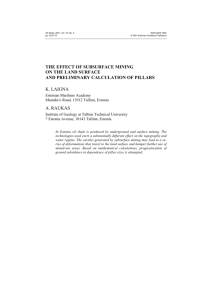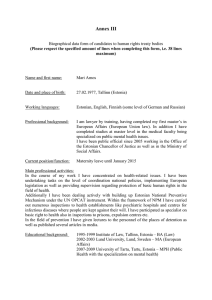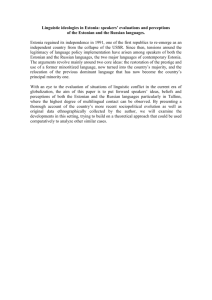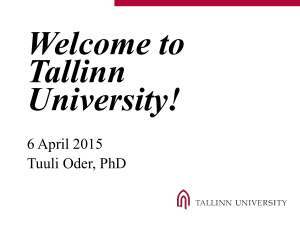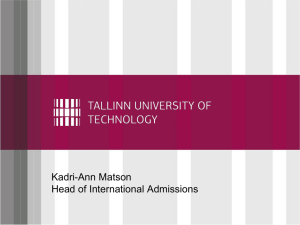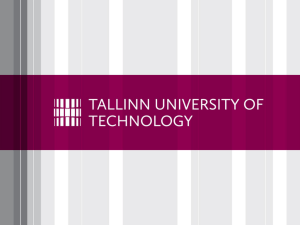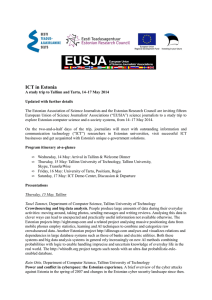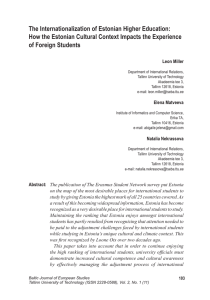Institutional Accreditation Decision Tallinn University of Technology
advertisement
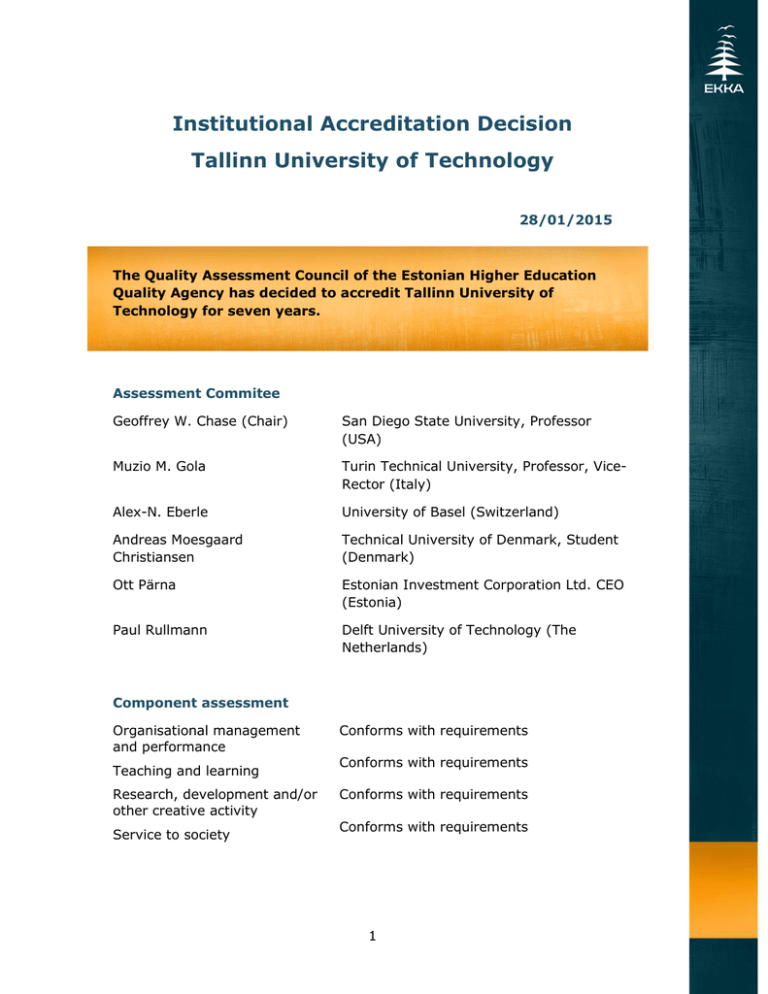
Institutional Accreditation Decision Tallinn University of Technology 28/01/2015 The Quality Assessment Council of the Estonian Higher Education Quality Agency has decided to accredit Tallinn University of Technology for seven years. Assessment Commitee Geoffrey W. Chase (Chair) San Diego State University, Professor (USA) Muzio M. Gola Turin Technical University, Professor, ViceRector (Italy) Alex-N. Eberle University of Basel (Switzerland) Andreas Moesgaard Christiansen Technical University of Denmark, Student (Denmark) Ott Pärna Estonian Investment Corporation Ltd. CEO (Estonia) Paul Rullmann Delft University of Technology (The Netherlands) Component assessment Organisational management and performance Teaching and learning Research, development and/or other creative activity Service to society Conforms with requirements Conforms with requirements Conforms with requirements Conforms with requirements 1 Strenghts and areas of improvement Organisational Management and Performance Strengths The goals of Tallinn University of Technology (hereinafter referred to as University) as set out in its Development Plan – to become an internationally recognised research university and to contribute to economic development and innovation via regional colleges and connecting with enterprises – are impressively ambitious and reflect the values shared by the University community. Achievement of the goals identified in the Development Plan is monitored on a regular basis. The University community shares the opinion that the University serves its students and society well. The University assists students as they seek internships and career opportunities and provides support to students with special needs. Students understand and support the University’s mission and values. There is a collaborative, open and supportive atmosphere at the University. This has made it easy for stakeholders to offer feedback, and management welcomes all such feedback. External communication is well managed with a recognisable style. The University’s international branding may serve as an example for other Nordic universities. Constant flow of internal information and communication via social media and blogs also reaches the students and is more and more multilingual. The University has effective information systems. Employers are pleased with University graduates and alumni appreciate the competencies they acquired at the University. University employees enjoy their work and highly appreciate their working conditions. Salaries of the University academic staff are higher relative to other Estonian universities. In recent years, the University has significantly upgraded its infrastructure with new facilities, dormitories, campus and modern learning conditions which provide excellent teaching, learning and research opportunities. 2 Areas for Improvement and Recommendations The ambition expressed by the leadership – that in the future the University will be among the top universities in the world – would be entirely appropriate to be incorporated into the University’s strategic plans and to be communicated broadly. Considering the University’s goal to become internationally known, the University should increase international benchmarking and best practice learning. The University must encourage international mobility of students and staff in both directions. In order to ensure young successors as older generations retire, funds will need to be made available to recruit highly qualified academic staff. The University should analyse the effectiveness of sabbatical leaves in terms of research productivity of its staff. The University’s financial situation is insecure because of the recession and the political uncertainties. Considering that competition for research money in Estonia is becoming fiercer and outcomes will be unpredictable, the University must develop a strategy for funding models, as one of its priorities. Teaching and Learning Strengths The University’s commitment to internationalisation is impressive, the International Relations Office has done a commendable job. The University has set specific goals regarding student admission, and collects data to determine whether these goals have been met. The University provides comprehensive support for students relating to a wide variety of their concerns, which can be considered good practice not only in Estonia but internationally as well. The University takes into consideration the needs of all important stakeholders when developing its study programmes. New information and communication technology-related study programmes, taught in English, clearly serve the interests of the society both in Estonia and internationally. 3 Areas for Improvement and Recommendations The University should create centres of excellence or interdisciplinary teams, which are focused on both teaching and research, and include staff as well as students. It is necessary to reduce the number of study programmes throughout the University in order to facilitate focusing and interdisciplinarity in all University activities. The University must determine for all students whether their levels of previous education allow them to achieve success in their planned studies, or develop effective programmes to improve academic success for students with lower levels of preparation. The University should more efficiently collect feedback from different stakeholders (including alumni abroad), and further develop its feedback system to increase the response activity and produce a more systematic implementation of the feedback received. In order to promote cooperation between the University and internship enterprises, it is necessary to develop a web-based application to support the feedback system. The University should pay more attention to the assessment of learning outcomes and periodic reviews of assessment criteria. It is also recommended that the University: - work cooperatively with other international universities to identify best practices for assessing student learning; - examine the level of preparation of incoming students in terms of indirect indicators (surveys, employment data, etc.) as well as direct indicators (theses, examinations). It is recommended that the University establish a task force to examine student progress and submit annual data related to: - progress of students with remedial needs; - factors preventing the continuity of studies (work, financial pressures, mobility, etc.); - the effectiveness of student learning; - the effectiveness of “high-impact” practices (undergraduate research, study abroad, etc.). 4 In terms of analysing graduation and achievement data, it is useful to study models that have already been successfully implemented in Europe, the United States, and Canada. The University must take additional steps to reduce dropout rates. It is important that, beside international rankings, the University adequately focuses on goals related to teaching and learning, and supports progress of all of its students equally in all cycles. Research, Development and/or Other Creative Activity Strengths The University R&D strategy is clear and comprehensive, and marketing is excellent. The University has a broad portfolio of research areas, covered by eight faculties, four specialised institutes and five colleges. The University participates in seven centres of excellence and five competence centres. The University has developed a research centre: the Innovation and Business Centre Mektory. The Research Administration Office is very successful in supporting scientists with their research proposals and with a minimum of bureaucracy. The University has an extensive international network for research and teaching including more than 70 universities in Europe, the Americas, Asia and Australia. Collaboration with employers is also good. Despite the intense competition in Estonia, the University has very successfully managed to obtain over 80% of its research budget from the state budget and the ESF funds. As much as 11% of University research funding is received from businesses, for whom the University provides contractual research. Bringing nearly all of the structural units of the University to the same campus offers a great advantage of closer collaboration through joint use of research infrastructure and daily exchanges among scientists. Areas for Improvement and Recommendations 5 In order to continue promoting visibility and the good impact of the University, it is necessary to publish results of all research areas in highranking journals. University research groups should be restructured in order to involve more young top-talent. The University should invest in research-based teaching, and recruit researchers with pedagogical competencies. The Research Administration Office, Mektory and other relevant units should seek research funding from as many different sources as possible. The University should increase research funding from European Union and other international sources, increase contract work with industry and perform more joint projects with international universities and companies. The University must find ways to considerably increase the number of doctoral students and annual defences of theses in order to attain European averages over the next ten years. Improving the quality of doctoral studies requires the Rectorate’s continued attention. It is necessary to strengthen teaching and research project supervision in the different research areas, primarily in those research groups where this is not yet up to standard. It is necessary to encourage collaboration among doctoral students as well as among different faculties, and bypass supervisors who are not successful. Service to Society Strengths Overall, the University has increased its visibility in recent years due in part to different initiatives such as launching the European Innovation Academy and Tallinn Science Park TEHNOPOL activities. The University Innovation and Business Centre Mektory is open to everyone and often hosts both local and international guests. The centre attracts prestigious entrepreneurs, partners , and internationally successful start-up companies. Development of the Estonian start-up community over the recent 5–7 years together with its apparent successes has positively affected life on 6 the campus as well, and has promoted technology education and business more widely. University staff believe that the reputation of the University is much better than 3–4 years ago – the number of external cooperation proposals has increased significantly. The University has ambitious plans for the Open University, including online education through international platforms. Lifelong learning is also high on the agenda. Alumni contributions to teaching by giving voluntary courses is significant. Such contributions are particularly important in the areas like ICT and business economics, as it is hard to hire top-quality people in these fields because salaries are not competitive with industry. In-company training and open learning have proven to be successful and they fit in the University’s vision that it must serve the interests of society as well as strengthen its ties with companies. Areas for Improvement and Recommendations It is recommended that the University enters into a more permanent dialogue with Estonian companies when planning in-service training, lifelong learning and retraining activities. It is necessary to promote cooperation between the University and the Education Technology Centre by using the experience gained in distance learning and on-line learning. It is necessary to balance the learning programmes of in-service training and retraining between purely academic single courses and more practical, problem-solving courses. The University must find balance between the needs of society and business, and the interests affecting its own competitiveness. Thus, the university gains the opportunity to acquire a leading position in restructuring Estonian economy. Further information: Self-Evaluation Report Assessment Report 7
